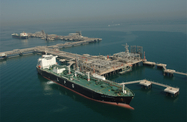Extensive investments in gas recovery technology look set to reduce Qatar’s carbon footprint, with newly opened facilities aiming to boost production and earnings whilst minimising wastage.
Described as one of the largest environmental protection developments in the world, the Jetty Boil-Off Gas Recovery Project (JBOG) was officially inaugurated in April despite starting operations at the end of last year. The $1bn facility at Ras Laffan Industrial City captures gas which would otherwise be lost in the process of loading liquefied natural gas (LNG) tankers.
The Ras Laffan terminal, operated by Qatargas, has the capacity to load six LNG ships at the same time, making it the world’s largest LNG export terminal. During the process, it is estimated that 1% of gas is lost, or boiled off during the loading process, due to the chilled liquid gas being pumped into the warmer tanks of the LNG carriers. In most cases there is no mechanism to collect this low-pressure gas and it has to be flared or burnt off.
The JBOG facility will help reduce Qatar’s greenhouse gas emissions by up to 1.6m tonnes annually, capturing 90% of the gas that would otherwise be lost and helping to lower the country’s carbon production and release levels.
The facility, which has recovered gas from 500 vessels loaded at the terminal since it began operations, counts Qatar Petroleum, ExxonMobil, Total, ConocoPhillips and Shell amongst its major stakeholders. During the launch ceremony, Saad Sherida Al Kaabi, president and CEO of Qatar Petroleum and chairman of Qatargas, said the JBOG Project was the largest and most comprehensive of the group’s initiatives to exploit the country’s resources and protect the environment. “The JBOG Project demonstrates the commitment of Qatar to balance industrial development with care for the environment,” he said.
Earnings potential
The project represents a significant investment in terms of its contribution to the economy due to the fact that the recovered gas will be reprocessed so it can either be exported as LNG or used as gas fuel.
Working at full capacity, the unit can recover around 2.8m cu metres of natural gas per day, giving an annualised total of 600,000 tonnes of LNG − a considerable addition to Qatar’s LNG output of 77m tonnes last year. While lower gas prices may mute the returns from the JBOG plant in the shorter term, commercial gains from the project will improve if energy prices rise.
Declining energy prices will inevitably impact Qatar, as will the increasingly competitive nature of the LNG global market, given Qatar position as the world’s largest LNG exporter. Yet Qatar is well equipped to deal with such challenges, given the size of its reserves, the long-term commitment of its international and local partners, and its financial reserves.
QAFAC boosts output through recovery
Another project aimed at reducing emissions and adding value to production processes was announced in February. Qatar Fuels Additives (QAFAC), a joint venture between Industries Qatar and OPIC Middle East, developed the QR145.5m ($40m) carbon dioxide recovery unit at its Mesaieed Industrial City site. The plant has the capacity to recover 500 tonnes of carbon dioxide daily, with the captured gas to be turned into methanol.
Speaking at the launch of the facility in February, QAFAC CEO Nasser Jeham Al Kuwari said initial results of the project had shown an improvement in both output and earnings. “After conducting a thorough feasibility study to examine the technical and economical benefits of the project, a cost analysis showed the project has definitely helped increase our production and profit,” he said.
The recovery unit is expected to boost QAFAC’s methanol output by around 90,000 tonnes annually, adding to the roughly 1m tonnes the company produced through additional investments by the end of last year.

